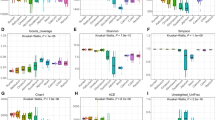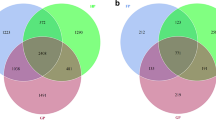Abstract
The microbial community present in forage peanut, a tropical legume, and its silages are unknown. For this reason, we used the Ion Torrent platform to study the bacterial community present in this legume during silage fermentation. Forage peanut was harvested at the start of flowering with a backpack mower and was chopped with a stationary ensilage cutter and then ensiled in bags measuring 25.40 cm × 35.56 cm, in triplicate. The bags were opened after 1, 3, 7, 14, 28 and 56 days of fermentation. Primers targeting the 16S rDNA gene were used, and the PCR products were used in library preparation and sequencing using the Ion Torrent platform. In total, 721,837 sequences were obtained and processed using the program MOTHUR v.23.0. The sequencing result revealed that the genus Weissella was present at the different periods of fermentation of peanut silage in greater amounts than the other genera (Bacillus, Rummeliibacillus, Enterococcus, Lactobacillus, Pediococcus). The six libraries constructed reached high coverage value (0.999). Comparison of the number of operational taxonomic units (OTUs) between the forage crop and the silages with 14 and 56 days of fermentation revealed that some sequences were exclusive to the plant and others to fermentation periods. The silage with 28 days of fermentation remained distant from the other fermentation periods in regard to microbial diversity. Knowledge of the diversity of different bacterial genera through sequence analysis can guide bioprospecting studies.





Similar content being viewed by others
References
Parvin S, Nishino N (2010) Succession of lactic acid bacteria in wilted rhodesgrass silage assessed by plate culture and denaturing gradient gel electrophoresis. Jpn Soc Grassl Sci 56:51–55
Mcgarvey JA, Franco RB, Palumbo JD, Hnasko R, Stanker L, Mitloehner FM (2013) Bacterial population dynamics during the ensiling of Medicago sativa (alfalfa) and subsequent exposure to air. J Appl Microbiol 114:1661–1670
Merriman B, Rothberg J (2012) Progress in torrent semiconductor chip based sequencing. Electrophoresis 33:3397–3417
Eikmeyer FG, Kofinger P, Poschenel A, Junemann S, Zakrzewski M, Heinl S, Mayrhuber E, Grabherr R, Puhler A, Schwab H, Schluter A (2013) Metagenome analyses reveal the influence of the inoculants Lactobacillus buchneri CD034 on the microbial community involved in grass ensiling. J Biotechnol 167:334–343
Liu L, Li Y, Li S, Hu N, He Y, Pong R, Lin D, Lu L, Law M (2012) Comparison of next-generation sequencing systems. J Biomed Biotechnol 2012:1–11
Hamady M, Walker JJ, Harris JK, Gold NJ, Knight R (2008) Error-correcting barcoded primers for pyrosequencing hundreds of samples in multiplex. Nat Methods 5:235–237
Muyzer G, de Waal EC, Uitterlinden AG (1993) Profiling of complex microbial populations by denaturing gradient gel electrophoresis analysis of polymerase chain reaction-amplified genes coding for 16S rRNA. Appl Environ Microbiol 59:695–700
Jenkins SN, Rushton SP, Lanyon CV, Whiteley AS, Waite IS, Brookes PC, Kemmitt S, Evershed RP, O’Donnell AG (2010) Taxon-specific responses of soil bacteria to the addition of low level C inputs. Soil Biol Biochem 42:1624–1631
Schloss P, Westcott S, Ryabin T, Hall J, Hartmann M, Hollister E, Lesniewski R, Oakley B, Parks D, Robinson C, Sahl J, Stres B, Thallinger G, Van Horn D, Weber C (2009) Introducing mothur: open-source, platform-independent, community-supported software for describing and comparing microbial communities. Appl Environ Microbiol 75:7537–7541
Quince C, Lanzen A, Davenport RJ, Turnbaugh PJ (2011) Removing noise from pyrosequenced amplicons. BMC Bioinform 12:38
Pruesse E, Quast C, Knittel K, Fuchs B, Ludwig W, Peplies J, Glockner F (2007) SILVA: a comprehensive online resource for quality checked and aligned ribosomal RNA sequence data compatible with ARB. Nucleic Acids Res 35:7188–7196
De Santis TZ, Hugenholtz P, Larsen N, Rojas M, Brodie EL, Keller K, Huber T, Dalevi D, Hu P, Andersen GL (2006) Greengenes, a chimera-checked 16S rRNA gene database and workbench compatible with ARB. Appl Environ Microbiol 72:5069–5072
Klockea M, Mundta K, Idlera C, Mceniryb J, O’kielyc P, Barth S (2006) Monitoring Lactobacillus plantarum in grass silages with the aid of 16S rDNA-based quantitative real-time PCR assays. Syst Appl Microbiol 29:49–58
Whiteley AS, Jenkins S, Waite I, Kresoje N, Payne H, Mullan B, Allcock R, O’Donnel A (2012) Microbial 16S rRNA ion tag and community metagenome sequencing using the ion torrent (PGM) platform. J Microbiol Methods 91:80–88
Mahanna WC (1993) Silage fermentation and additive use in North America. In: Silage production from seed to animal, Proceedings, New York, NRAES, pp 85–95
Agarussi MCN, Pereira OG, Leandro ES, Ribeiro KG, Santos SA (2018) Fermentative profile and lactic acid bacterial dynamics in non-wilted and wilted alfalfa silage in tropical conditions. Mol Biol Rep 46(1):451–460
Huys G, Leisner J, Bjorkroth J (2012) The lesser lab gods: Pediococcus, Leuconostoc, Weissella, Carnobacterium and affiliated genera. Lactic acid bacteria: microbiology and functional aspects, 4th edn. CRC Press, Boca Raton, pp 102–104
Siezen R, Tzenwa VA, Castioni A, Wels M, Phan HTK, Rademaker JLW, Starrenburg MJC, Kleerebezem M, Molenaar D, Vlieg JETH (2010) Phenotypic and genomic diversity of Lactobacillus plantarum strains isolated from various environmental niches. Environ Microbiol 12:758–773
Ni K, Zhao J, Zhu B, Su R, Pan Y, Ma J, Zhou G, Tao Y, Liu X, Zhong J (2018) Assessing the fermentation quality and microbial community of the mixed silage of forage soybean with crop corn or sorghum. Bioresour Technol 265:563–567
Ni K, Wang F, Zhu B, Yang J, Zhou G, Pan Y (2017) Effects of lactic acid bacteria and molasses additives on the microbial community and fermentation quality of soybean silage. Bioresour Technol 238:706–715
Acknowledgements
This work was supported by Fundação de Amparo a Pesquisa de Minas Gerais (FAPEMIG) and Coordination for the Improvement of Higher Education Personnel (CAPES).
Author information
Authors and Affiliations
Corresponding author
Ethics declarations
Conflict of interest
The authors declare no conflicts of interest.
Additional information
Publisher's Note
Springer Nature remains neutral with regard to jurisdictional claims in published maps and institutional affiliations.
Electronic supplementary material
Below is the link to the electronic supplementary material.
Rights and permissions
About this article
Cite this article
dos Santos Leandro, E., de Oliveira, M.N.V., Rufino, L.D. et al. Microbial characterization of Arachis pintoi and its silages at different fermentation periods. Mol Biol Rep 46, 5019–5024 (2019). https://doi.org/10.1007/s11033-019-04952-y
Received:
Accepted:
Published:
Issue Date:
DOI: https://doi.org/10.1007/s11033-019-04952-y




